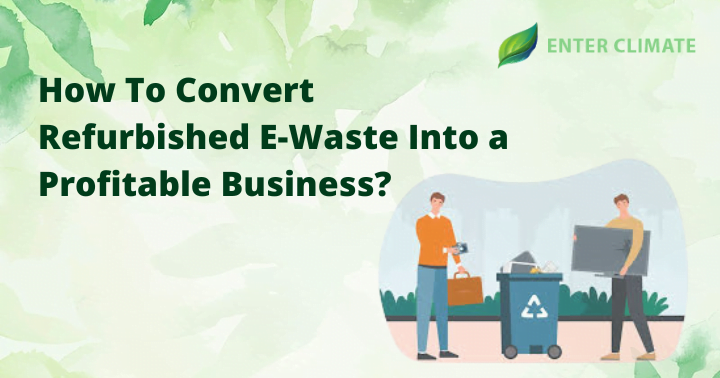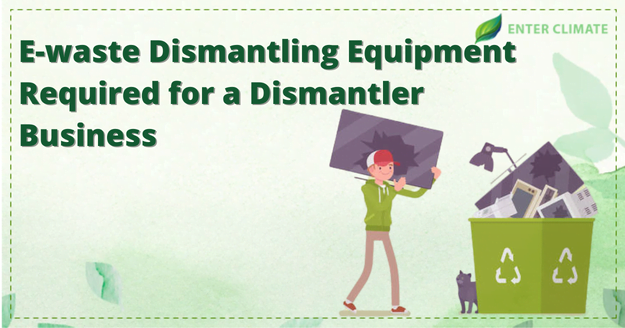How to convert refurbished e-waste into a Profitable Business?
 25 Aug, 2022
25 Aug, 2022 
Under E-Waste Management Rules, 2016, refurbishment is defined as the procedure that expands the quality of disposed Electrical and Electronic Equipment (EEE) registered under Schedule I to increase their lifetime. Furthermore, a refurbisherisan individual is involved in the refurbishment business of used Electrical and Electronic Equipment (EEE). This blog will elaborate on converting refurbished E-Waste into a profitable process.
Refurbishment of EEE (Electric and Electronic Equipment) contribute to reducing e-waste in numerous ways, including:
• Finding new homes for working equipment that no longer needs to be used and refurbishing it.
• Testing and maintaining equipment for businesses so they may use it for longer;
• Refurbished E-Waste has new compatible components with older generations of equipment to extend their useful lives and increase performance.
• Replacing damaged parts to prolong the life of current equipment.
Advantages of Refurbished E-Waste over Recycling
Refurbishment, which includes reusing older equipment, is often considered better than recycling. Some of the other reasons are: –
- It is estimated that EEE (Electric and Electronic Equipment)refurbishment is way better for the environment than recycling. The reason for doing so is that recycling later results in carbon dioxide emissions, which is not the case with the process of getting refurbished e-waste.
- Refurbishment uses fewer resources and is a more straightforward process than recycling, a highly complex procedure that uses many resources.
- The refurbishment has a more profitable market and thus has created more jobs and revenue.
- Refurbishment is better for the environment as it reduces the amount of E-Waste by reusing the older equipment.
Market Overview of a Refurbished E-Waste business
Published by Transparency Market Research, the new market report regarding global refurbished computers and laptops markets estimate that the global market will reach the worth of an estimated US dollar Billion by 2027. Similarly, the economy is approximated to increase at a Compound annual growth rate of 11% from 2019 to 2027.
Further, as per International Solid Waste Association (ISWA)[1], an estimated 44.7 metric tons of E-Waste is generated, among which only 20% of e-waste can be recycled, leaving 80% of the E-Waste to be refurbished; in contrast, the other hand, only 5% of the E-Waste can be recycled, leaving 95% of the e-Waste for refurbishment, creating more opportunities for refurbished business.
Apart from this, day by day, there has been a rise in the demand for refurbished devices from ITES and the IT sector.
Responsibility of the Refurbisher
Refurbisher is defined under E-Waste (Management) Rules, 2016 as an individual involved in the refurbishment industry. Refurbishment is a part of the Waste Management process and usually yields refurbished e-waste. Therefore some accountabilities are given to the refurbisher as a part of the principle of Extended Producers’ Responsibility. Some of the duties of the refurbisher are: –
- The refurbisher shall gather E-waste generated during the course of the refurbishment process and transfer them to an approved dismantler or recycler.
- Refurbishers need to guarantee the state that their refurbishment process does not damage the environment by putting away and transporting E-waste.
- Refurbishers are also responsible for filing a yearly report by 30th June to the respective State Pollution Control Board following the year to which the return relates.
- The refurbisher is answerable for the industry running, warranting that it does not jeopardize the public’s health or the environment.
- On top of that, the refurbisher must keep a record of E-Waste handled in Form-2, making it available to concerned authorities for inspection.
- E-waste management also needs to be recorded by the refurbisher, and the relevant authority should inspect the documents.
Eligibility for Setting up a Refurbishment Business
The refurbishment, if compared to the Recycling process of E-Waste, has proven to be more beneficial because it not only reduces E-Waste but also considerably improves the product and the lifespan of EEE (Electrical and Electronic Equipment). Undoubtedly, the result, i.e., refurbished e-waste, is the product that can be used again instead of disposed of. But, before starting a refurbishment industry, an individual has to keep exact conditions in mind:-
- Firstly, for starting a business, the refurbisher needs to have adequate space and property where all the E-Waste can be gathered.
- Once the land is acquired, the refurbisher should ensure that closed spaces (similar to the factory)are set up in the establishment.
- After that, the refurbisher also needs to have functioning equipment mandatory for the refurbishment process.
- Ultimately, the business needs an experienced and knowledgeable workforce before applying for the license.
Documents Involved in Refurbisher Authorisation and License
While filing for Refurbishment Authorisation, Refurbisher has to submit a number of attested documents like: –
- Aadhar Card
- PAN Card
- GST Certificate
- State Pollution Control Board issued Consent to establish The Air Act, of 1981 and The Water Act, of 1981.
- State Pollution Control Board issued Consent to Operate under The Air Act, 1981 and The Water Act, 1981.
- Authorisation granted by the District Industries Centre or any other competent agency.
- Electricity Bill of the established unit
- Layout/Plan
- Certificate of Incorporation (CIN)
- MOA (Memorandum of Association) (If required)
- AOA (Article of Association) (if required)
Procedure for acquiring Refurbisher Authorisation and License
The process for obtaining E-Waste Refurbisher Authorisation from State Pollution Control Board is regulated under E-Waste Management Act, 2016. The procedure involves Filing an application to start the business to get refurbished e-waste, reviewing the submitted application and granting the license.
Filing an application– Before filing for an application, the refurbisher must register through the official online portal of the State Pollution Control Board and fill out Form-I (a) stipulated under E-Waste (Management) Rules, 2016, along with Applicable Fee and the attested documents. The unique application number may also be provided to track the status of the application.
Submitting/Review Application– Following the filing of the application, it is required to be submitted with the required documents, after which the application is sent to concerned personnel of the State Pollution Control Board for review to check compliance with the guidelines. In case of any error with the application submitted with the document, it is sent back to the refurbisher for rectification.
Grant of license– After the inspection, if there is no mistake in the application submitted and all the documents are certified, the authentication license is granted.
Conclusion
India ranks amongst one of the top five nations for generating e-waste. Also, it is one of the fastest-growing economies, with a lot of potential market for refurbished E-Waste business, which will ultimately contribute not only to the country’s development but has also proved to be more beneficial for the environment and human health as opposed to the recycling process.
Read our Article:How to Obtain E-Waste Business License for Refurbishing












